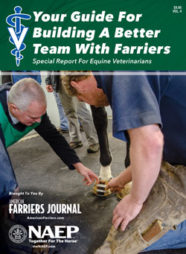Researchers in Berlin compared the performance of regional nerve blocks with intra-articular analgesia while evaluating horses presented to a university veterinary hospital for foot lameness.
The lameness examinations, which included a body mounted inertial sensor system, were conducted over 3 days with palmar digital and abaxial sesamoid regional nerve blocks performed on day 1 and intra-articular analgesia of the coffin joint and navicular bursa performed on days 2 and 3. Twenty-three horses, most of them warmbloods, showed at least a 70% improvement to the regional nerve blocks included in the study.
There was no significant association between improvement following the regional nerve blocks and the joint blocks. At 2 and 5 minutes following the injections, there were significant differences in improvement of lameness between the coffin joint and navicular bursae responses; however, these differences were not apparent after 10 minutes. The authors concluded that palmar digital and abaxial sesamoid nerve blocks are not reliable enough to distinguish pain originating between the coffin joint and the navicular bursa. In addition, while analgesia of the bursa was stable over time, analgesia of the coffin joint changed over the course of 10 minutes.
The authors recommend the interpretation of intra-articular analgesia during lameness examination be done within 2 to 5 minutes for the best accuracy.
— Katrinaki V et al. EVJ 2022;13583
Learn More
- Dealing with Thrush and White Line Disease: Combining topical treatments with good hoof care will help you keep these common problems under control.
- Why Equine Bones Break and Tendons Rupture: Understanding anatomy and physics can help prevent severe injuries.
- Back Up the Horse’s Entire Foot, Not Just the Toe: Dressing the heels appropriately makes it easier to control the toe.






